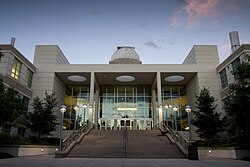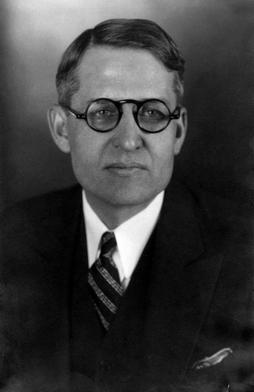
Harvey Fletcher was an American physicist. Known as the "father of stereophonic sound", he is credited with the invention of the 2-A audiometer and an early electronic hearing aid. He was an investigator into the nature of speech and hearing, and made contributions in acoustics, electrical engineering, speech, medicine, music, atomic physics, sound pictures, and education. Following his death, he was credited with collaborating with his doctoral advisor, Robert Millikan, on the Nobel-prize winning oil drop experiment which first determined the charge of the electron.
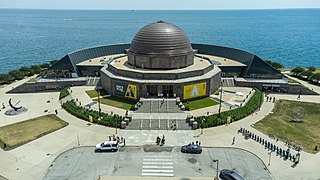
The Adler Planetarium is a public museum in Chicago, Illinois, dedicated to astronomy and astrophysics. It was founded in 1930 by local businessman Max Adler. Located on the northeastern tip of Northerly Island on Lake Michigan, the Adler Planetarium was the first planetarium in the United States. It is part of Chicago's Museum Campus, which includes the John G. Shedd Aquarium and The Field Museum. The Planetarium's mission is to inspire exploration and understanding of the universe.

Morehead Planetarium and Science Center is located on the campus of the University of North Carolina at Chapel Hill. As a unit of the university, Morehead receives about one-third of its funding through state sources, one-third through ticket and gift sales, and one-third through gifts and grants.
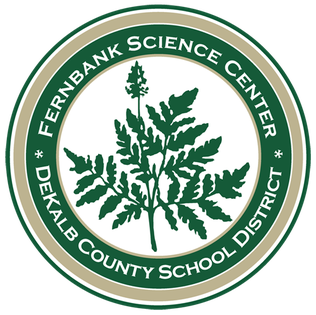
The Fernbank Science Center is a museum, classroom, and woodland complex located in Atlanta. It is owned and operated by the DeKalb County School District, which announced in May 2012 it was considering closing the facility to cut its annual budget, then quickly shelved the plan after public outcry. The nearby Fernbank Museum of Natural History is a private non-profit organization that is separate from the Science Center.

The Maryland Science Center, located in Baltimore's Inner Harbor, opened to the public in 1976. It includes three levels of exhibits, a planetarium, and an observatory. It was one of the original structures that drove the revitalization of the Baltimore Inner Harbor from its industrial roots to a thriving downtown destination. In 1987, an IMAX theater was added, but the museum continued to show its age as the end of the 20th century approached. In May 2004, a large addition to the property was opened, and the modernized hands-on exhibits now include more than two dozen dinosaur skeletons. Subjects that the center displays include physical science, space, and the human body.

Telus World of Science Edmonton (TWOSE) is a broad-based science centre in Edmonton, Alberta, Canada, operated by the (non-profit) Edmonton Space & Science Foundation. The centre is located on the southwest corner of Coronation Park in the neighborhood of Woodcroft. The science centre houses 144,430 sq. ft. of public space and is the largest science centre in Western Canada. It is currently a member of both the Association of Science-Technology Centers (ASTC) and the Canadian Association of Science Centres (CASC).
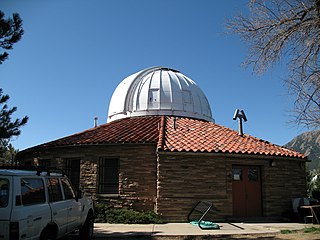
Sommers–Bausch Observatory is an astronomical observatory located on and owned by University of Colorado Boulder. The building was initially completed in 1953 and named after Elmer E. Sommers and Carl L. Bausch.

The Houston Museum of Natural Science is a natural history museum located on the northern border of Hermann Park in Houston, Texas, United States. The museum was established in 1909 by the Houston Museum and Scientific Society, an organization whose goals were to provide a free institution for the people of Houston focusing on education and science. The museum complex consists of a central facility with four floors of natural science halls and exhibits, the Burke Baker Planetarium, the Cockrell Butterfly Center, and the Wortham Giant Screen Theatre. In 2022, the museum received 1,520,000 visitors, making it seventh on the List of most-visited museums in the United States, and was the third most-visited U.S. science museum. Much of the museum's popularity is attributed to its large number of special or guest exhibits.
The Ira A. Fulton College of Engineering represents Brigham Young University's (BYU) engineering discipline and includes departments of chemical, civil, electrical and computer, and mechanical engineering and the school of technology. The college awards about 700 degrees every year and has almost 3,600 students.

The Planetarium Science Centre is a department in the Bibliotheca Alexandrina in Alexandria, Egypt. It promotes science centres as an educational tool.
Fred Lewis Markham was an American architect in the early 20th century who designed movie theatres and many buildings on the campus of Brigham Young University (BYU) in Provo, Utah.

Carl Ferdinand Eyring was an American acoustical physicist. He was the dean of the College of Arts and Sciences at Brigham Young University (BYU) for 26 years and was also the vice president of the Acoustical Society of America from 1950 until his death in 1951.

The Brigham Young University (BYU) College of Fine Arts and Communications (CFAC) is one of the nine colleges at the university, a private institution operated by the Church of Jesus Christ of Latter-day Saints and located in Provo, Utah. Founded in 1925, the college has grown from a small college of the arts with minimal faculty and only 100 students to the second largest college on campus.

William F. Edwards was a businessman and educator who held the Driggs Chair of Finance at Brigham Young University (BYU).
The BYU College of Physical and Mathematical Sciences was first organized in 1949 the College of Physical and Engineering Sciences. Engineering was later separated off and merged with the College of Industrial and Technical Education to form the College of Engineering and Technology. The founding dean of the newly formed College of Physical and Mathematical Science in 1972 was Jae R. Ballif.

The Buhl Planetarium and Institute of Popular Science Building, also known as the "People's Observatory", is located at 10 Children's Way in the Allegheny Center neighborhood of Pittsburgh, Pennsylvania.

West Mountain Observatory (WMO) is an astronomical observatory located on West Mountain near the community of West Mountain, Utah United States, about 22 km (14 mi) southwest of Provo. The observatory is owned and operated by Brigham Young University (BYU), and opened in 1981 after increasing light pollution reduced the utility of the Orson Pratt Observatory on the BYU campus. The first year of observing with the new 0.9 m telescope included imaging of intrinsic variable stars and high-mass X-ray binaries. Past research topics include light curve analysis of Delta Scuti variable stars and identifying pre-main-sequence stars by searching for H-alpha emitting objects.

The College of Science at the University of Utah is an academic college of the University of Utah in Salt Lake City, Utah. The college offers undergraduate and graduate degrees in atmospheric science, biology, chemistry, geology and geophysics, mathematics, metallurgical engineering, mining engineering and physics and astronomy.
